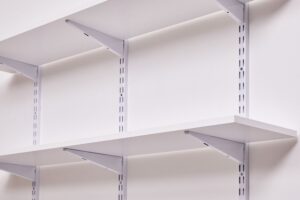Shelf brackets are essential components in modern interior design, combining functionality with aesthetics. They serve as the foundation for shelving systems, ensuring stability and providing a decorative element to complement various styles. Whether you’re setting up storage in a garage or installing elegant display shelves in a living room, choosing the right shelf brackets is crucial.
Types of Shelf Brackets
There are numerous types of shelf brackets available, each designed for specific purposes:
- L-Brackets:
The most common type, L-brackets, are simple and reliable. Shaped like the letter “L,” they provide excellent support for lightweight to medium-weight shelves. These are ideal for bookshelves, kitchen shelves, and small display areas.

- Floating Brackets:
Floating brackets are hidden within the shelf itself, creating a seamless, minimalist look. They are perfect for modern and contemporary spaces where clean lines are desired. - Heavy-Duty Brackets:
Designed for industrial or utility use, heavy-duty brackets are robust and capable of supporting substantial weights. They are commonly used in garages, workshops, or pantry storage. - Decorative Brackets:
These brackets combine function with form. They often feature intricate designs, making them a statement piece in any room. Decorative brackets are commonly made of wrought iron, brass, or intricately carved wood. - Adjustable Brackets:
Adjustable brackets allow flexibility in shelf placement, making them suitable for spaces that require adaptable storage solutions.
Materials and Finishes
Shelf brackets come in various materials to suit different needs:
- Metal: Durable and versatile, metal brackets are available in aluminum, steel, and iron. They are often powder-coated for added protection and style.
- Wood: Wooden brackets add warmth and charm, making them ideal for rustic or traditional interiors.
- Plastic: Lightweight and affordable, plastic brackets are suitable for light-duty applications.
Finishes include matte black, polished chrome, antique bronze, and natural wood tones, allowing you to match brackets with your interior decor.
Choosing the Right Bracket
To select the appropriate shelf bracket, consider the following:

- Weight Capacity: Always check the weight limit of the brackets to ensure they can support your shelves and the items you plan to store.
- Shelf Size: The depth of the shelf determines the size of the bracket. Ideally, the bracket should be at least two-thirds the depth of the shelf.
- Aesthetic Appeal: Choose brackets that complement the overall style of your space.
Installation Tips
Installing shelf brackets may seem straightforward, but a few tips can ensure success:
- Use a level to ensure the brackets are aligned properly.
- Secure brackets into wall studs for maximum stability.
- Use appropriate screws and anchors based on your wall type (drywall, brick, or wood).
- Measure and mark your placement before drilling holes to avoid errors.
Popular Applications
Shelf brackets are used in various settings:
- Living Rooms: Floating brackets for sleek book displays.
- Kitchens: L-brackets for open shelving to store utensils and spices.
- Garages: Heavy-duty brackets for organizing tools and equipment.
- Offices: Adjustable brackets for flexible storage solutions.
Conclusion
Shelf brackets are more than just a means to hold up a shelf; they are integral to the design and functionality of a space. By understanding the different types, materials, and installation techniques, you can make informed choices that enhance your home or workplace. Whether you’re aiming for utility or style, the right shelf brackets can transform any room into an organized and aesthetically pleasing environment.

